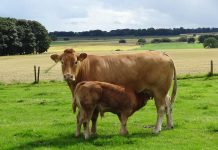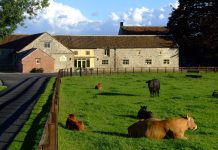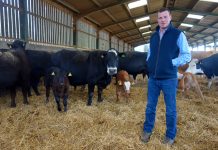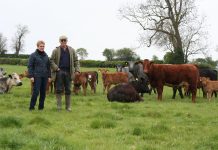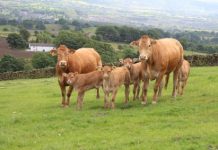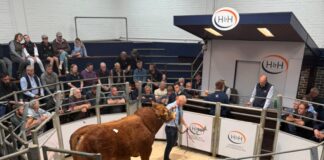Farm feature on Andrew and Mark Brown, Asby Hall, Nr Appleby, Cumbria
The Limousin is unbeatable for producing calves that can earn a premium price at that early age, says Cumbria suckled calf producer Andrew Brown who runs 100 suckler cows with his brother Mark at Asby Hall near Appleby.
“Our calves have very little cost on them before they’re sold. Suckler margins are tight so it’s important to get as much natural growth from a calf as you can without additional cost.
“Our spring born calves are probably only eating about £40 worth of feed between August and the time we sell them in November. If we have to over-winter a housed calf from November to the suckled calf sale in May it adds on another £200-£250 a head – even though it may be worth a bit more”
The Browns farm 450 acres on land running to 1000ft and keep 700 Swaledales and 100 North of England Mules alongside their successful suckler herd. The farm also carries 30 pedigree Bluefaced Leicesters under the Asby Hall prefix and has sold tup lambs to £9000.
Mule gimmer lambs bred at Asby Hall have won the championship at the Kirkby Stephen NEMSA sale for four years out of the last six.
Andrew and Mark are well known for producing top quality suckled calves and the prices they achieve each autumn is testament to the reputation they have achieved over the years with discerning buyers.
Calves bred at Asby Hall regularly top the main suckled calf sale at Kirkby Stephen Auction Mart – a sale that always attracts many of the season’s most sought after calves.
 The herd’s record price is £2750 paid for an eight month British Blue sired heifer bred out of a Rossignol sired Limousin cow. The calf went on to claim the supreme championship at the noted primestock show at Wigton in west Cumbria the following year. . Recent sale toppers at Kirkby Stephen have sold for £2000 and £2300.
The herd’s record price is £2750 paid for an eight month British Blue sired heifer bred out of a Rossignol sired Limousin cow. The calf went on to claim the supreme championship at the noted primestock show at Wigton in west Cumbria the following year. . Recent sale toppers at Kirkby Stephen have sold for £2000 and £2300.
The £2000 bid came for Kirkby Stephen’s 2013 supreme champion – an eight-month-old Limousin cross heifer sired by the Rocky son Gallaber Dynamic that the Browns bought from the Sedgwick family of Burton-in-Lonsdale, Ingleton.
“We bought Dynamic when he came up for sale at Bentham at the market’s June Cattle Fair in 2010. He’s registered but had torn his ring out.
“He was a tremendous bull on the day and he’d have made a lot more than the £3000 we paid for him if he’d have been offered at a breed sale at Carlisle.
“He’s done a fantastic job for us. He’s a really thick bull all round but he has a bit more stretch than some of the bulls we’ve used in the past. He’s produced some top quality calves for us as well as the champion at the Kirkby Stephen sale,” says Andrew.
Cows at Asby Hall calve from early March to late May having run with two Limousin bulls and one British Blue.
`We buy in around 12 eight to twelve-month-old suckled heifer calves from other good herds every year to rear up into herd replacements. We never buy cows with calves at foot and find it’s more cost effective to have a system of buying-in young heifers at around £1000-£1200.
Limousin bulls are used on 70 of the Limousin x British Blue cows. “The best calves for the show job are threequarter Limousin and one quarter British Blue,” says Andrew.
Cows are housed from mid-October and run in strawed cubicles and fed an ad-lib silage and straw diet.
“We add the straw to keep some control over the cows’ body condition and to avoid them getting too “good” by the time they calve. The cows are scanned a month after housing.
“We re-stocked with beef-cross cows after foot and mouth instead of the dairy crossed we used to have. A lot of people said they wouldn’t have enough milk but we’ve worked away with them over the last 15 years and we’ve never found that to be a problem.
“What we’ve benefitted from is the shape of these cows which gives us a head start when it comes to producing top quality suckled calves.”
After calving in individual pens the cows and calves are moved to cubicle accommodation at the family’s other farm. The diet is switched to 100% grass silage and the calves have access to a creep area, although no additional feed is offered to calves at this stage.
Ideally cows and calves are turned out by mid-May after all the calves are de-horned and the bull calves have been castrated.
Creep feeders are introduced from early August offering a grower pellet. “We want as many calves away as we can in the November sale.
“About a month beforehand we gather the cows and calves and decide what heifer calves we’ll retain for breeding and what steer calves will be sold.
“We keep these calves inside, still on their dams, until the morning of the sale. We’ve tried weaning them sooner but the calves do better left on the cows until sale day. The heifer calves being retained are sent back to the allotments with their mothers but all the newly weaned cows are kept inside.”
The better steer calves weigh around 300-350kg. The later-born calves are over-wintered and sold as strong stores the following May.
Andrew’s main criteria for bull selection are conformation, mobility and pedigree – but he knows the sort of pedigree that will produce the “shapey” calves the Browns are well known for.
“We’ve had a lot of success with the French breeding that gives us that really full back-end that we want in our suckled calves so that we can get them away young and at the best price.”
Gallaber Dynamic is by Rocky who is full brother to Rossignol so it’s no surprise that another influential bull used at Asby Hall was the Rossignol son Cloughhead Ulaberlu from George Hutton who is bred out of a Broadmeadows Cannon sired cow.
“He’s done a great job for us and he’s still working at 14 years old,” says Andrew.
“Growth, stretch and the ability of spring born calves to develop shape and conformation is what we need to make a mark in the autumn suckled calf sales.”
Just under 70 suckled calves at around seven to eight months old went under the hammer from Asby Hall last autumn and realised an average of almost £1000 apiece. And that’s no flash in the pan; the year before a similar number levelled at £1045
Last autumn’s top price was £1650 paid for a steer by the Gallaber sire and this spring saw a 10-month heifer calf make £1750.
The issue of the finished beef market now demanding cattle at lighter weights is having an impact on every stage of the production cycle but Andrew and Mark Brown believe the qualities of the Limousin are unequalled in producing cattle to suit tightening specifications.
“There’s certainly no need for us to change anything we’re doing because the type of cattle the Limousin is producing for us is providing the ideal size and shape for finishers to work with – especially now that cattle need to carry enough finish but to weigh less,” says Andrew.
While there’s always stiff competition for the Asby hall calves from those looking for future tickets in the primestock show rings, it’s the regular East coast finishers that take the Brown’s cattle year after year that are responsible for the consistently average high prices they achieve.









